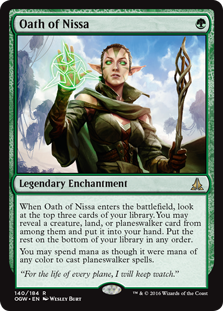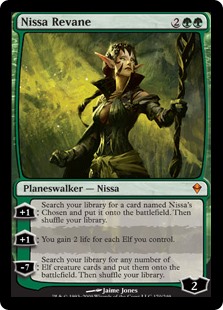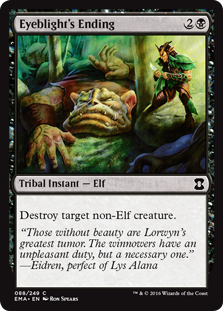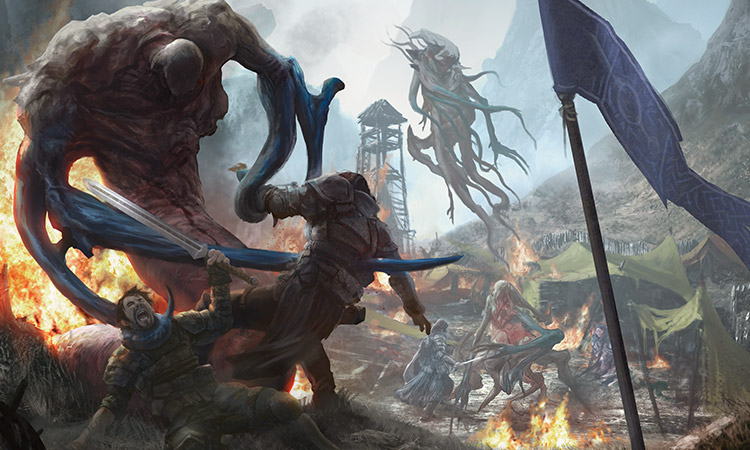This piece has been a long time in the making. Aside from Magic, my biggest hobby is writing my own novels and stories. For years, I’ve wanted to combine those two passions and talk about the effort that goes into making the lore and story-crafting of Magic. When the opportunity to do so came up, there was one topic that I needed to talk about first. Or should I say one character?
No, not that one.
There we go.
Alright, fine. I’ll be talking about both Nissas. For those of you who only started caring about the story around the time of Magic Origins, let me explain. Magic as a game has always had something of a tumultuous relationship with its own lore. For a long time it was relatively common for elements of past stories to be changed without explanation.
There were a lot of reasons why: the often glacial pace of storytelling, changeovers in the creative staff, and the needs of Magic the game coming before those of Magic the story are just a few of the more obvious ones. If you want a particularly glaring example, go read Agents of Artifice and you’ll see Jace, Liliana and Tezzeret traipsing around Ravnica. Everything’s normal, except the guilds don’t exist in a meaningful way. That book is set a mere three to four years before Return to Ravnica Block, and according to some stuff that Liliana said in a recent installment of Magic Story, Agents of Artifice is still supposed to be canon. Which is baffling.
These moments were always confusing, but they were largely accepted as an inevitable result of multiple authors. That changed when Magic Origins shone a spotlight on the story for the first time in years. The thing is, as they started to roll out the new story installments a small outcry broke out. The reason? Nissa’s backstory had changed significantly and there was a vocal group of players that took it as a personal offense, given that this set that was supposed to finally treat the story with the respect it deserved.
First off, this article is going to be a two-parter. I want to cover it all in one article but no matter how I break it down there’s just too much to talk about. Today I’m going to examine Nissa’s past up until the Magic Origins reboot. But more importantly, I’ll be focusing on the audience’s perception of the character leading up to that point to really see why the retcons got the response that they did.
As always, the best place to start is at the beginning. Funny thing is, I don’t mean Zendikar. As a character, Nissa exists for an interesting reason. When the original Duels of the Planeswalkers game was being made, every deck was themed to belong to a specific planeswalker character. Since this was 2009, they only had nine characters to work with, and really eight because Bolas didn’t get a deck until a later expansion. Given the color distribution between the existing walkers, it was decided to add a green/black deck to the game. For whatever reason (e.g. the recent printing of Lorwyn), this deck was designed to be an Elf Tribal strategy and then Nissa was created from scratch to serve as the deck’s face.
The thing is, this was a green-black elf deck, themed mostly around the rather racist elves of Lorwyn.
A a result, the original concept of Nissa was intended to be a villainous character, vaguely disconcerting in her design and far from noble in her motives or goals. Her original character biography illustrates this best:
Nissa Revane is a proud and ruthless nature-mage. She seeks to prove that her people, the elves, are the true heirs and best stewards of the planes of the multiverse. Nissa prefers action to words. She’s a master summoner, and she knows the blades and arrows of her elf warriors speak louder than any rhetoric.
Nissa Revane is an Elf nature-mage from the plane of Zendikar. Raised by the warrior culture of the Joraga tribe, she was taught that elves were inherently superior to all others and the rightful shepherds of nature itself. Her travels have only strengthened this view and wherever she goes she tries to learn the proper way of things from the elves of whatever plane she visits.
I’m not going to post the full bio, but that introduction paints a rather stark contrast to the Nissa appearing in stories today. Ironically enough, Nissa’s original bio didn’t get taken down from the Wizards website until a few months after Magic Origins came out, when it was replaced with this one.
The response to Nissa was extremely positive, which led to the character being slotted into the original Zendikar Block and becoming the point of view character of In the Teeth of Akoum. Her portrayal in this book was mostly consistent with what little was known up to this point. She wasn’t using black mana yet, but one of the biggest themes in the book is that Nissa has an understandable and deep-seated mistrust of vampires that puts her at odds with Anowan and eventually Sorin Markov, who’d been pretending to be human for most of the story.
That distrust led to Nissa sabotaging Sorin’s efforts to reseal the Eldrazi and instead unleashing them on Zendikar in the hopes that they’d flee her homeland and find another plane to destroy.
Oops.
And at this point the story went cold. The wheel of Magic lore turned, and Nissa and Zendikar both faded into the background for years, overshadowed by the Phyrexians, Liliana’s quest to literally kill her demons, and several other long-running stories that stole the spotlight. But just because Nissa’s story didn’t evolve during this time doesn’t mean that nothing happened.
You see, in the four years between when Rise of Eldrazi faded off the map and when Nissa got her next peek into the spotlight along with the Magic 2015 core set, the player’s perception of Nissa shifted. Or to be more accurate, it solidified. Nissa didn’t get the best portrayal in In the Teeth of Akoum; and whether it was WotC’s intention or not, that book earned her a reputation for not being very smart. At the same time, because Duels of the Planeswalkers originally introduced her as a green/black mage but Nissa didn’t have access to black mana in the Zendikar story, it was a common assumption that the version of her we’d seen so far was pre-Lorwyn. The next leap of logic said that the next time Nissa appeared it would be with a multicolored card as she turned to the most dangerous magic at her disposal to drive the Eldrazi from her home plane, aligning herself with the radical ideology of the Lorwyn elves in the process.
I’m well aware that there’s very little in the way of evidence there, but this theory was simple, lined up with the available facts, created a satisfying character arc and, thanks to the glacial pace of storytelling at the time, had no source to refute it. As such it became entrenched. It was common during this time to hear Nissa be referred to simply as “Elf Hitler” because—as far as her character went—that’s all that we had to go on.
Nissa’s next appearance came with the printing of Nissa, Worldwaker in the M15 Core Set, and while her mono-green card didn’t line up with expectations, it was a core set so that didn’t raise too many eyebrows. What a lot of people don’t remember is that Nissa also got featured in the Uncharted Realms column, where we got one short story’s worth of insight into what was happening on Zendikar as the Eldrazi ravaged it.
In the story Nissa is rescued from certain death by a mixed band of humans and kor, who tell her that Ulamog wiped out the Joraga. Injured, weak, forced to rely on the very people she was taught to be xenophobic about, and with Eldrazi decimating land and people indiscriminately, Nissa had to confront her tribalism and the guilt of knowing she was almost solely responsible for the devastation. Once she’d healed, Nissa and the rest of the group attack one of Ulamog’s Pathrazers, and Nissa summons earth elementals to beat the monstrosity to death.
This is significant for a couple of reasons. Firstly and most obviously, it was clearly intended to be the start of a redemption storyline for Nissa. She was working with (and more importantly trusting) non-elves, which was a huge shift for her character but one that didn’t feel out of place given what had happened. Secondly, it marked a change in Nissa’s abilities. Up until this point Nissa had been portrayed as a summoner, as well as having support magic to protect and heal her elvish kin. Exactly why they made the change I don’t know, but I suspect is has something to do with how difficult summoners are to write, especially ones that mostly summon sentient creatures.
While this story didn’t get a lot of attention from what I remember, it did make it pretty clear that we weren’t getting elf-supremacist Nissa anytime soon. However, that expectation was still there. We as a community had been thinking about her that way for five years, and the idea was pretty darn entrenched.
And now we come to Magic Origins. One of the most important things to realize about this part of the story is the order in which information was revealed. One of the first details we got was that the set would feature ten planes, representing the home plane and first destination of the five planeswalkers. We knew Zendikar was Nissa’s home, but pretty early on WotC released a chart showing which plane filled which role, and we discovered that the first plane Nissa ever traveled to was Lorwyn.
You can probably imagine the reaction to this news. Finally we were going to see the tie-in back to the original incarnation of elvish isolationist Nissa, to actually see her at her most villainous point before she could move on to the heroic role that she’d organically grown into. It would’ve been the perfect arc to wrap up everything about her character while leaving her future wide open. I can’t really speak for other people, but I so badly wanted this to happen.
As for what happened in the Magic Origins story, that’s going to have to wait for another article. It’ll come soon, I promise. This topic is one that I’ve wanted to cover for ages, and I won’t leave you hanging any longer than I have to. My next article is going to be a deck editing piece, but I’ll be back after that to finish the tale of Nissa Revane.
For now, I’ll leave a link to the first appearance of the new Nissa for anyone who wants to see what I’m talking about for themselves.
And if you want one of your commander decks to be featured in a future Dear Azami, send your decklist to dearazami@gmail.com, along with a brief introduction describing the problems your deck is having, as well as the budget you have to work with and any other relevant information.
Levi Byrne has won games of Magic with Leviathan and Levitation.





